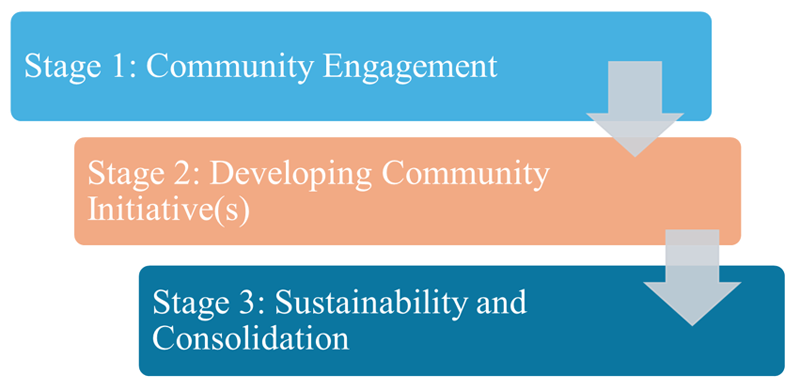Section Two: How to Implement Social Capital
How to Implement Social Capital Development Projects
Social capital development is a practical process. Project teams need to plan, design, and adopt appropriate strategies according to the different stages of development in the practical process. Project teams may also refer to the "Working from the Ground-up approach" to motivate the participation of community members at different stages of development, thereby developing sustainable social capital (Fung et al., 2023; Goodwin & Yeung, 2013) (Figure 14).

First Stage: Community Engagement
Community engagement is the foundation of social capital development. Project teams may consider starting from residents' perspectives, working with community members to identify the community needs and issues of concern, and promoting their active participation.
- Communication and Listening
The first step in initiating community engagement is to establish effective communication channels and listen to the voices and opinions of community members. The project team may kick off by using the assessment of community needs and assets for establishing community communication channels. They may collect opinions from community members and other stakeholders through personal interviews, focus group discussions, and residents' meetings. The assessment findings can be used for advancement to the next stage (Working from the Ground-up (WFGU), 2015). - Building Partnerships
Project teams may establish good cooperative relationships with different groups and organisations within the community, such as schools, religious organisations, other local groups, social services or professional institutions. This approach helps promote the project, recruit community members, and facilitate the project's advancement. The project team may also develop collaborative partnerships with these groups and organisations based on community needs and strategies. - Capacity Building
Project teams may recruit community members through the "House Captain and Volunteer Development Model" and provide training and support to enhance their capacity to participate in social capital development (see Social Capital Intervention Model). Project teams may also plan and organise various community activities, volunteer services, and community groups to provide participation platforms for community members, increasing their experience in community involvement and building relationships and trust among members (Laverack, 2001).
Second Stage: Developing Community Initiative(s)
Building on community engagement, the second stage focuses on planning and implementing specific community projects/initiatives to address community members’ needs, strengthen community connections, and establish community support networks.
- Planning and Goal Setting
Based on the community assessment results, project teams may work with community members to determine the project's goals and priorities. Project teams may organise and develop different community groups, such as those for the elderly, women, youth, and men, with reference to the assessment results and the characteristics of community members. Together with these groups, they can set common goals, prioritise them, and plan the project's strategies and content. Involving community members in the decision-making will enhance their level of participation (Liberato et al., 2011). - Resource Mobilisation
Project teams may mobilise resources within and outside the community, such as engaging community organisations or collaborative partners to assist with advancing community projects. Project teams may work with members of various community groups to identify suitable resources within and outside the community. They can help connect them with resident organisations, religious groups, businesses, and external entities such as the business sector, professional organisations, and higher education institutions, promoting project advancement and the development of cross-sector social capital (Goodman et al., 1998). - Project Implementation, Monitoring, and Evaluation
Based on the priorities of community members, project teams may collaborate with them to implement various community projects/initiatives, such as neighbourhood mutual help, community education, or public health promotion projects. During the process, the project team should encourage community members to plan and act together without deviating from the project's original goals and targets. Continuous communication with community members through meetings or establishing a monitoring and evaluation mechanism to assess the progress and effectiveness of the project are measures to enhance community participation and encourage them to take ownership (Chaskin, 2001; Liberato et al., 2011).
Third Stage: Sustainability and Consolidation
The objective of the final stage is to ensure the sustainability of community projects/initiatives and integrate the experience gained during the implementation process in preparation for the continued development of social capital after the funding period expires. Project teams may work with community members and collaborative partners to establish a sustainable operational model, which includes resource mobilisation, sustainable implementation plans, evaluation, and feedback mechanisms (WFGU, 2015).
Back to Table of Contents Page 1 2 References